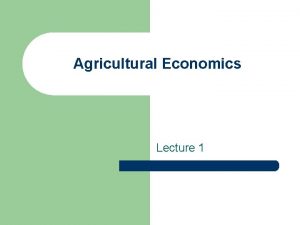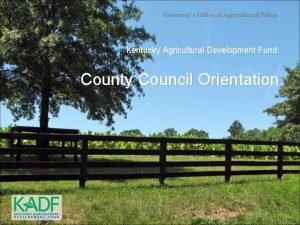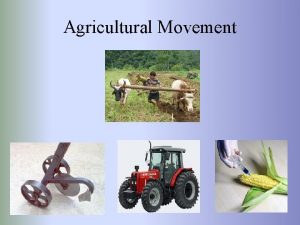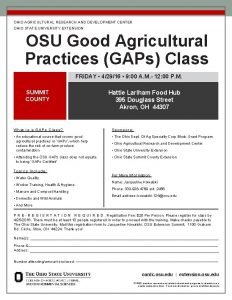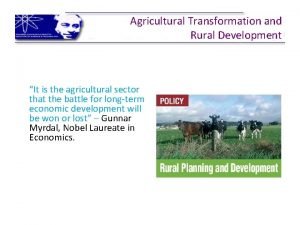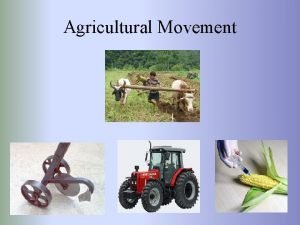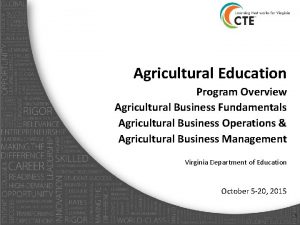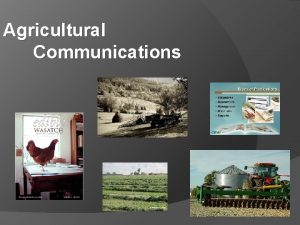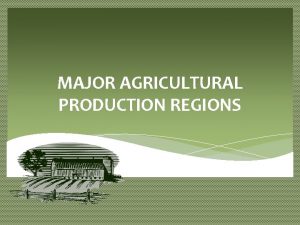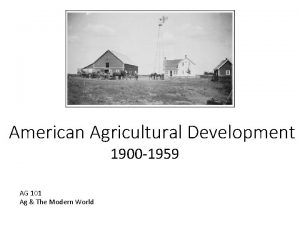American Agricultural Development AG 101 Ag The Modern









































- Slides: 41

American Agricultural Development AG 101 Ag & The Modern World

“Those who labor in the earth, are the chosen people of God. ” Thomas Jefferson - 1784

Native American Farming: Pre Colonial Contact • Influenced by Mesoamerican Indians • American Indians manipulate land for crops • Primarily with fire (slash & burn) over centuries • Practiced soil rotation • Cultivated maize, beans, squash • Larger populations in the South due to more sophisticated agricultural systems

Native American Farming: Post Colonial Contact • Epidemic diseases introduced by Spaniards • Wiped out entire native populations in Caribbean • Mortalities from disease also seen in Southeast • Mississippian Indian cultures decimated by disease by 1600 • Deaths greater among old and young • Loss of manpower made it difficult to maintain agricultural systems and fire regimes • Loss of elderly, storehouse of knowledge, tradition and custom • Arrival of English continued epidemic diseases

The 1600’s • Establishment of the American Colonial Period • Land remained under British control • British Crown carved land into large chunks and granted to private companies or well connected individuals • Grantees divided land further and sold to other individuals • Settlers in this century were often poor • Settled as “squatters” without clear title to land • Believed land should be given for free if they remained on the land worked land

The 1600’s • As the English gained control of America, their merchants • During the winter of 1609 to 1610, sought new markets for colony two-thirds of the settlers in crops. Jamestown, Virginia, the first permanent English settlement in America died. • Native Americans taught the survivors how to grow corn, pumpkin and squash. • Corn and beans were planted together in small mounds so the bean vines could grow up along the cornstalks. • The beans also added nitrogen to the soil. Pumpkins and other kinds of squash were planted between the mounds. Seeds were saved for the next year’s crop. • The British government imposed heavy duties on many agricultural products from the colonies and limited the export of more valuable products like tobacco, indigo, wheat and livestock. • These restrictions created resentment among the Colonists and were a major cause of the American Revolution.

The 1700’s • Northern farmers produce a variety of crops and livestock • Sometimes supplemented by craftwork • Southern “Plantation” agriculture concentrates on export crops • Tobacco = main cash crop • Colonies export: • Tobacco • Rice • Indigo • Grain • Meat products • Local governments often regulate the prices of basic food

American Agrarianism • Agrarian: defined by Merriam-Webster • of or relating to or characteristic of farmers or their way of life • of or relating to fields or lands or their tenure • Agrarianism: defined by Merriam-Webster • “a social or political movement designed to bring about land reforms or to improve the economic status of the farmer” • US has a history of political commitment to place control of land under primary producers (vs. European feudal system, land owned by aristocrats and landlords)

American Agrarianism “Cultivators of the earth are the most valuable citizens. They are the most vigorous, the most independent, the most virtuous, and they are tied to their country, and wedded to its liberty and interests by the most lasting bonds. ” Thomas Jefferson, Farmer • Political duty is to preserve and protect farmers • A population that owns & works its land is less susceptible to short-term, unstable government policies • Farming creates democratic virtues (moral standards) • Independence and self-reliance • Commitment to the common good • Farmers are virtuous, their means of making a living meld together private and public interest

American Agrarian Philosophy “I know of no other pursuit in life in which more real and important services can be rendered to any country than by improving its agriculture, its breed of useful animals, and other branches of husbandman’s care. ” George Washington “Those who labor the earth are the chosen people of God. ” Thomas Jefferson • Science and development of the scientific method influenced plant cultivation, animal husbandry, development of agricultural technology • Early settlers went to the New World to escape religious persecution • Farming perceived as a spiritual quest of faith

American Revolution: 1776 • Colonies revolted against trade taxations and power of England over them. • 1776: Declaration of Independence = Partially a result of British controls on: • Farm exports • Restrictions on land titles • Limitations on western settlement

Did you know? • 1780: U. S. Ambassador Ben Franklin sends soybeans back from France • 1786: George Washington breeds the first mules in the U. S. • Used animals given to him by the King of Spain • Also experimented with crop rotation

The 1700’s • Both Washington and Jefferson were interested in experimenting with agriculture. • Washington: At his Mount Vernon, Virginia farm, Washington experimented with crop rotation and with new seeds and plants. He also became the Nation’s first mule breeder, using animals given to him by the king of Spain. • Jefferson: Enjoyed experimenting with agriculture on his Virginia estate at Monticello. • Both Washington and Jefferson helped organize societies for improving agriculture. These societies were pioneers in agricultural science and education. Some societies issued reports, published journals, and sponsored agricultural fairs to encourage agricultural improvement. • 93% of early Americans were farmers

1790’s • 1790: • Total Population = 3. 9 million • 90% = Farmers • Value of tobacco exports = $4. 4 million • = 44% of total exports

1790’s Innovations • 1793 = Invention of Cotton Gin (Eli Whitney) • Revolutionized the Cotton Industry • +/- effects

1790’s Innovations • 1794 = Thomas Jefferson creates plow with lower resistance moldboard • Thomas Jefferson writes about American Agriculture as a way of life (“Agrarian”) • 1797 = first cast-iron plow patented • Began to use horsepower to pull newly invented farm implements • Broadcast seeder • Mechanized Reaper

1790’s • 1796: Public Land Act • Allows Federal land sales to the public • Minimum of 640 -acre plots • $2 per acre of credit • Immigrants: • Came to America in droves, exchanging their own indentured labor for passage. • 1799: • George Washington suggests to Congress the establishment of a National Board of Agriculture

The 1800’s • 1800: • Total Population = 5. 3 million • Average value of Ag exports = $23 million • 75% of total exports

1803: The Louisiana Purchase • $15 million • Roughly doubled the size of U. S. territory • President Thomas Jefferson justified the purchase as a means to provide enough fertile land to expand the Agrarian way of life “Agrarian” = relating to farmers and their way of life Jefferson wanted to create a country of small farms living independently in states under U. S. governance Felt farmers had the virtues needed to sustain a Democratic society



1805 -1810 • 1805: Cotton begins to replace Tobacco as main cash crop of the South • 1810: Total Population = 7. 2 million • Ag exports = $40 million • 87% of total exports • Beginning of the “Industrial Revolution”

North Vs. South North : • Industrialized • Exporting manufactured goods • Immigrant Boom • Overall population increased South: • Exported: • Cotton, sugar, rice, tobacco, wheat • Depended heavily on food imported from upper Mississippi valley • Plantation system dependent on slave labor • Population stagnated

1810 -1850 • 1819 = U. S. canning industry started. • 1831 = the grain reaper invented. • 1837 = John Deere manufactures the steel plow. • 1843 = founding of the commercial fertilizer industry by developing a process for making superphosphate fertilizer. • 1845 -1855 = Great Potato Famine in Ireland • 1850 = mechanical cotton picking machine developed.

1850 -1860 • 1855 = Michigan and Pennsylvania established the first state agricultural colleges. • 1856 = A patent for condensing milk was issued to Gail Borden. • 1858 = Mason jars, used for home canning, were invented.

The “Cotton Boom” • 1790: U. S. exported 3, 000 bales of cotton • 1793: Invention of Cotton Gin • 1831: U. S. exports 800, 000 bales of cotton • 1860 = 5 million bales • Cotton now accounted for 2/3 of all U. S. foreign trade • The American South was the world’s top cotton producer

Manifest Destiny: 1840 s • The idea that America had a special destiny to stretch across the continent motivated many people to migrate West. • In 1845 John L. O'Sullivan, editor of the Democratic Review, referred in his magazine to America's "Manifest Destiny to overspread the continent allotted by Providence for the free development of our yearly multiplying millions. " One of the most influential slogans ever coined, "manifest destiny" expressed the romantic emotion that led Americans to risk their lives to settle the Far West.

Manifest Destiny: 1840 s • Manifest Destiny led expansionists to demand the U. S. should own the entire Pacific Northwest all the way to the southern border of Alaska. • Many invoked the idea to justify Indian removal, war with Mexico, and American expansion into Cuba and Central America. • More positively, the idea of Manifest Destiny inspired missionaries, farmers, and pioneers, who dreamed of transforming the great plains and fertile valleys into farms and small towns.

Civil War: 1861 -1865 • North: preserve the Union and end slavery • • South: to preserve economy and way of life At least 50% of population was slaves

1862: Lincoln Legacies • President Lincoln created the USDA • “The “People’s Department”, as Lincoln called it, was created to “acquire and to diffuse …. useful information on subjects connected to agriculture. ” • Signed Morrill Act • Gave each state 30, 000 acres of public land per seat held in Congress to build and maintain Agricultural Colleges • 1887: Hatch Act granted more land/funds for Ag Research • 1890: 2 nd Morrill Act funded black Agricultural Colleges

Investment in the Country’s Future Food Production & Supply • Government support of science, technology, and education to improve agriculture established a strong foundation for American agriculture • Gave US a competitive edge over rest of world • Development of new crop varieties (CA navel oranges, sugar beets for Midwest) • Animal husbandry & nutrition • Research in disease and pest management • Fertilizer testing programs • Information shared with farmers led continuous improvements in farm life and agricultural production

Post-Civil War South • The southern states were devastated by the Civil War. • Georgia lost 66% of its developed resources during the war. • Pre Vs. Post War Example: • Pre: Georgia had 1000+ plantations that were at least 1, 000 acres, • Post: Farm size based on the area a man could manage through his own labor, with the assistance of his family or contracted labor. • Plantations were in poor condition • Stock, mules and horses for plow-teams were scarce as was grain to feed them • Most of the seed was old and poor quality from neglect during the war

Reconstruction Era: 1860’s • 4 million freed slaves • Had no land, no $$ and little opportunity • Sharecropping: Southern form of tenant farming • Employed ex-slaves and other poor workers to farm plantations (cotton, tobacco) in exchange for part of the harvest • Many sharecroppers frequently were cheated and exploited • System remained for decades

African American Ag Innovators • Booker T. Washington • Believed Education = Emancipation • First Head of the Tuskegee Institute in AL • Provided Agricultural education/training for African Americans • George Washington Carver • Agricultural Scientist at Tuskegee • Taught soil conservation w/ crop rotation • Traveled to African American farms to demonstrate better farming methods • Introduced profitable new crops to grow vs. cotton • Peanuts • Discovered new varieties • Created new uses • Establishing a new industry for the South

George Washington Carver Discoveries • From peanuts: 300+ products including: • milk, cheese, cream, coffee, plastics, paper, wood stains, flour, soap, linoleum, cooking oils, cosmetics, etc… • From sweet potatoes: 118+ products including: • starch, tapioca, molasses, feed for livestock, dyes, flour, vinegar, ink, and synthetic rubber. • From cotton: • paving blocks, cordage, paper, fiber for rope, etc…

1862: The Homestead Act • Westward expansion pushed the agricultural frontier onto the Great Plains. • The Homestead Act offered 160 acres of FREE land to settlers who would farm it for 5 years. • Homesteaders rushed to fill the open lands. • Homesteading also brought fresh waves of immigrants – “Sodbusters” • The Great Plains soon became America’s breadbasket, the rich soil yielding bountiful harvests of wheat and corn.

1860’s: Reconstruction Era • 1861 = Pasteurization invented. • 1867 • Barbed wire invented. • Cattle boom. • Range wars break out between ranchers and farmers. • 1869 Transcontinental railroad completed.

Plight of The Native Americans • Bison population nearly extinct by 1870 • Continual forced movement westward by the U. S. government • 1887 Dawes Act divided up tribal land for Native Americans but also sold remaining plots to Homesteaders • Finally reversed in 1934 • Severely impacted Native American tribes, communities, structure, organization and ability to survive in the newly Homesteaded Prairie

The Development of the Industrial United States: 1870 -1900 • 1869: Wilbur Atwater, “Father of Human Nutrition” first discovered and published chemical compositions of foods • Later research focused on nutritional quality of cooked/processed foods • 1870: Refrigerator railroad car patented. • 1881: Hybrid corn produced. • Mid 1880’s • Texas = Main Cotton state • MN, CA, IL = Main Wheat states • 1887: The Hatch Experiment Station Act was passed • Provided federal grants to states for agricultural experimentation.

1880 – 1890 Stats 1880 • Total Population • 50 million • Farmers • 49% of labor force • Number of farms: • 4 million • Average acres • 134 acres 1890 • Total Population • 63 million • Farmers • 43% of labor force • Number of farms: • 4. 6 million • Average acres • 136 acres

The Emergence of Modern America: 1870 -1900 • 1888 = The first long haul shipment of a refrigerated freight car was made from California to New York. • 1892 = The gasoline tractor was built by John Froelich. • 1890 -1899 • Average annual consumption of commercial fertilizer • = 1. 8 million tons • 1895 = Automobile patent issued • 1898 = New Wheat Varieties imported from Russia • By 1904 Wheat production went from 60, 000 to 20, 000 bushels per year • 1902 The Reclamation Act was passed • Lead to water projects for irrigation.
 Development of modern american drama
Development of modern american drama Chapter 9 agricultural transformation and rural development
Chapter 9 agricultural transformation and rural development Chapter 9 agricultural transformation and rural development
Chapter 9 agricultural transformation and rural development What is agricultural development
What is agricultural development What is agricultural development
What is agricultural development Ag revolution kentucky
Ag revolution kentucky Stages of agricultural development
Stages of agricultural development Ohio agricultural research and development center
Ohio agricultural research and development center Arab organization for agricultural development
Arab organization for agricultural development Agricultural transformation and rural development
Agricultural transformation and rural development American legion post 101
American legion post 101 Modern american plated
Modern american plated Greek era floral design
Greek era floral design Best southern gothic novels
Best southern gothic novels Agile 101
Agile 101 Affordable housing development 101
Affordable housing development 101 Hình ảnh bộ gõ cơ thể búng tay
Hình ảnh bộ gõ cơ thể búng tay Slidetodoc
Slidetodoc Bổ thể
Bổ thể Tỉ lệ cơ thể trẻ em
Tỉ lệ cơ thể trẻ em Voi kéo gỗ như thế nào
Voi kéo gỗ như thế nào Tư thế worm breton là gì
Tư thế worm breton là gì Chúa yêu trần thế
Chúa yêu trần thế Các môn thể thao bắt đầu bằng tiếng chạy
Các môn thể thao bắt đầu bằng tiếng chạy Thế nào là hệ số cao nhất
Thế nào là hệ số cao nhất Các châu lục và đại dương trên thế giới
Các châu lục và đại dương trên thế giới Công thức tính thế năng
Công thức tính thế năng Trời xanh đây là của chúng ta thể thơ
Trời xanh đây là của chúng ta thể thơ Mật thư tọa độ 5x5
Mật thư tọa độ 5x5 101012 bằng
101012 bằng độ dài liên kết
độ dài liên kết Các châu lục và đại dương trên thế giới
Các châu lục và đại dương trên thế giới Thể thơ truyền thống
Thể thơ truyền thống Quá trình desamine hóa có thể tạo ra
Quá trình desamine hóa có thể tạo ra Một số thể thơ truyền thống
Một số thể thơ truyền thống Bàn tay mà dây bẩn
Bàn tay mà dây bẩn Vẽ hình chiếu vuông góc của vật thể sau
Vẽ hình chiếu vuông góc của vật thể sau Nguyên nhân của sự mỏi cơ sinh 8
Nguyên nhân của sự mỏi cơ sinh 8 đặc điểm cơ thể của người tối cổ
đặc điểm cơ thể của người tối cổ Ví dụ giọng cùng tên
Ví dụ giọng cùng tên Vẽ hình chiếu đứng bằng cạnh của vật thể
Vẽ hình chiếu đứng bằng cạnh của vật thể Tia chieu sa te
Tia chieu sa te



